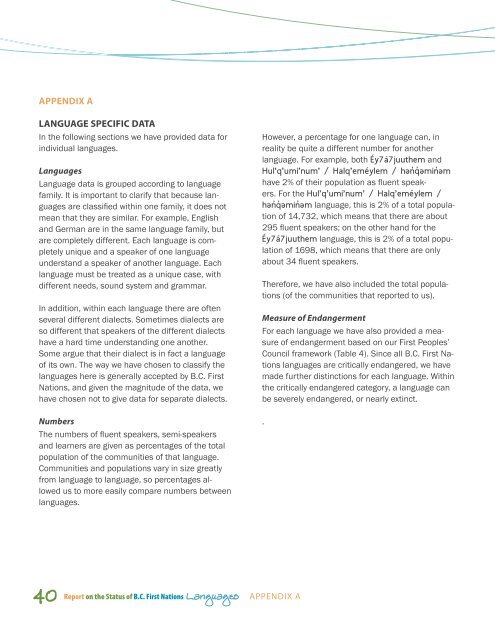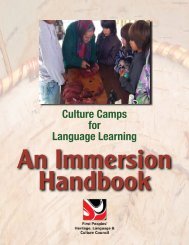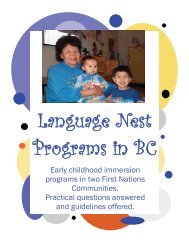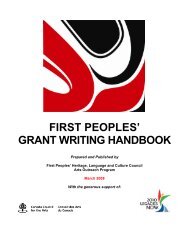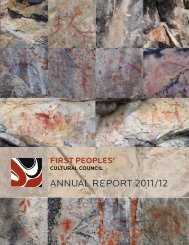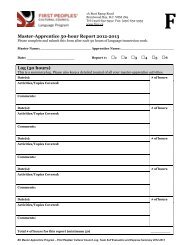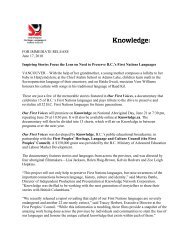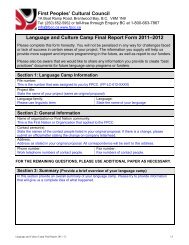What is the status of BC First nations languages? - First Peoples
What is the status of BC First nations languages? - First Peoples
What is the status of BC First nations languages? - First Peoples
Create successful ePaper yourself
Turn your PDF publications into a flip-book with our unique Google optimized e-Paper software.
APPENDIX ALanguage Specific DataIn <strong>the</strong> following sections we have provided data forindividual <strong>languages</strong>.LanguagesLanguage data <strong>is</strong> grouped according to languagefamily. It <strong>is</strong> important to clarify that because <strong>languages</strong>are classified within one family, it does notmean that <strong>the</strong>y are similar. For example, Engl<strong>is</strong>hand German are in <strong>the</strong> same language family, butare completely different. Each language <strong>is</strong> completelyunique and a speaker <strong>of</strong> one languageunderstand a speaker <strong>of</strong> ano<strong>the</strong>r language. Eachlanguage must be treated as a unique case, withdifferent needs, sound system and grammar.In addition, within each language <strong>the</strong>re are <strong>of</strong>tenseveral different dialects. Sometimes dialects areso different that speakers <strong>of</strong> <strong>the</strong> different dialectshave a hard time understanding one ano<strong>the</strong>r.Some argue that <strong>the</strong>ir dialect <strong>is</strong> in fact a language<strong>of</strong> its own. The way we have chosen to classify <strong>the</strong><strong>languages</strong> here <strong>is</strong> generally accepted by B.C. <strong>First</strong>Nations, and given <strong>the</strong> magnitude <strong>of</strong> <strong>the</strong> data, wehave chosen not to give data for separate dialects.NumbersThe numbers <strong>of</strong> fluent speakers, semi-speakersand learners are given as percentages <strong>of</strong> <strong>the</strong> totalpopulation <strong>of</strong> <strong>the</strong> communities <strong>of</strong> that language.Communities and populations vary in size greatlyfrom language to language, so percentages allowedus to more easily compare numbers between<strong>languages</strong>.However, a percentage for one language can, inreality be quite a different number for ano<strong>the</strong>rlanguage. For example, both Éy7á7juu<strong>the</strong>m andHul’q’umi’num’ / Halq’eméylem / hən̓q̓əmin̓əmhave 2% <strong>of</strong> <strong>the</strong>ir population as fluent speakers.For <strong>the</strong> Hul’q’umi’num’ / Halq’eméylem /hən̓q̓əmin̓əm language, th<strong>is</strong> <strong>is</strong> 2% <strong>of</strong> a total population<strong>of</strong> 14,732, which means that <strong>the</strong>re are about295 fluent speakers; on <strong>the</strong> o<strong>the</strong>r hand for <strong>the</strong>Éy7á7juu<strong>the</strong>m language, th<strong>is</strong> <strong>is</strong> 2% <strong>of</strong> a total population<strong>of</strong> 1698, which means that <strong>the</strong>re are onlyabout 34 fluent speakers.Therefore, we have also included <strong>the</strong> total populations(<strong>of</strong> <strong>the</strong> communities that reported to us).Measure <strong>of</strong> EndangermentFor each language we have also provided a measure<strong>of</strong> endangerment based on our <strong>First</strong> <strong>Peoples</strong>’Council framework (Table 4). Since all B.C. <strong>First</strong> Nations<strong>languages</strong> are critically endangered, we havemade fur<strong>the</strong>r d<strong>is</strong>tinctions for each language. Within<strong>the</strong> critically endangered category, a language canbe severely endangered, or nearly extinct..40 Report on <strong>the</strong> Status <strong>of</strong> B.C. <strong>First</strong> Nations Languages Appendix a


